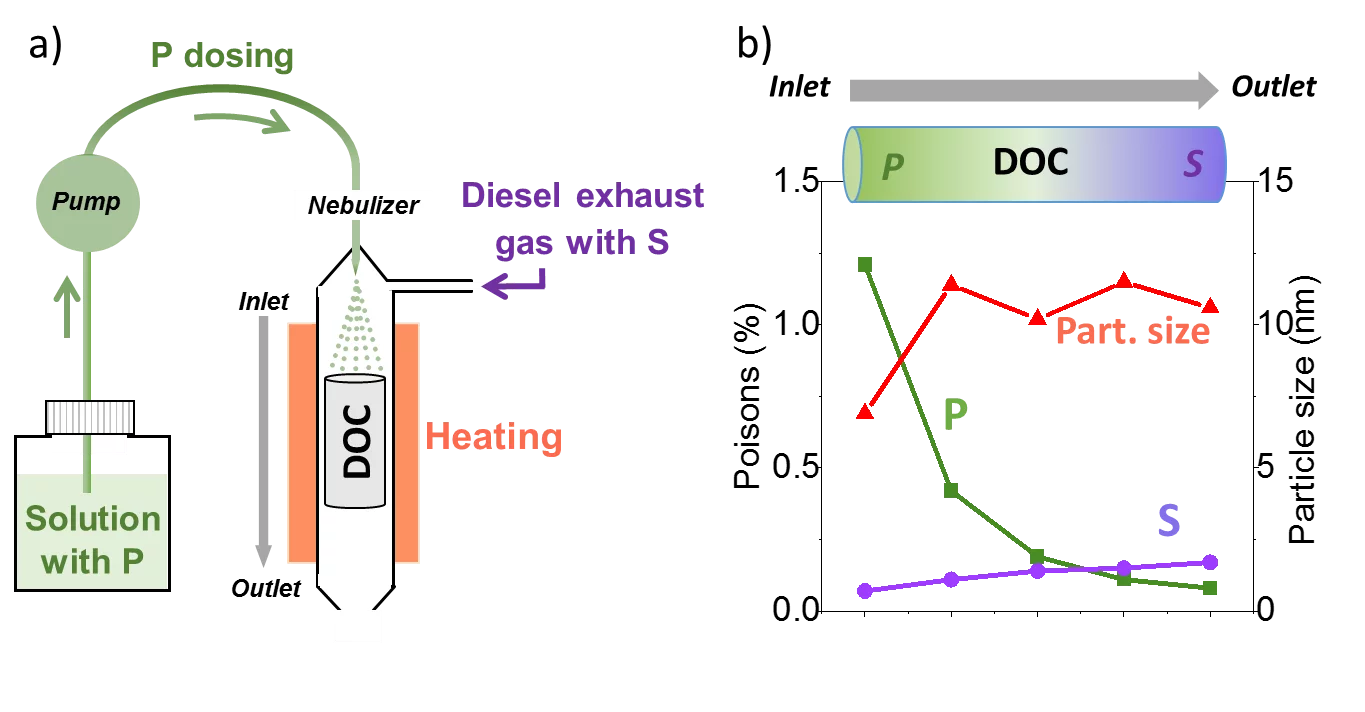PSI has collaborated with catalyst and engine manufacturers to understand the aging phenomena of emission control catalysts. To this end, a diesel oxidation catalyst with a relevant mileage was carefully analysed; the results suggest that a complex combination of poisoning and thermal sintering is the cause of deactivation during driving. A reactor setup was then developed to simulate poisoning and sintering effects for prediction of catalyst durability in time and cost effective manner.
Fossil fuels are expected to continue playing a relevant role in the case of heavy-duty vehicles, and the related noxious emissions (NOx, CO, unburned hydrocarbons – HC, and particulate matter) require mitigation by the use of efficient exhaust aftertreatment systems. In case of Diesel engines, the after treatment system includes a Diesel oxidation catalyst (DOC) which oxidises CO, HC and NO into less toxic compounds. Noble metal nanoparticles supported on Al2O3 are typically the active phase of the catalyst, which is then washcoated onto a cordierite substrate or monolith.
To meet current emission regulations, it is essential to understand and predict the long-term durability of DOCs during driving. In the last two years, researchers in the ACS group have closely collaborated with a catalyst supplier (Umicore) and a diesel engine manufacturer (Fiat Power Train) in order to unravel the DOC deterioration phenomena during vehicle operation. In the first part of this joint project, characterisation and activity measurements were performed on a DOC monolith extracted from a Diesel truck with 288,000 km. The study allowed the identification of two main deactivating agents:
- chemical poisoning (due to accumulation of P and S compounds from lube oil and fuel impurities) and
- noble metal sintering (due to occuring exothermal reactions during driving).
An in-depth analysis performed on six consecutive segments along the monolith revealed that P accumulation takes place preferentially in the inlet and in the top region of the washcoat, while S exhibits a reversed distribution (Fig. 1b). In combination with thermal effects, the distribution of P is believed to influence the size of noble metal particles along the monolith.
Hence, the results evidence that aging leads to radial and axial gradients on the DOC and that a strong relationship exists between the different deactivating parameters. This work illustrates the high complexity of the DOC aging phenomena and exposes the challenge to perform realistic laboratory-based predictions of catalyst durability.
The second part of the project focused on performing artificial catalyst aging. To this end, a setup was installed to expose an unused DOC to sequential poisoning and thermal treatments (Fig. 1a). The setup comprised a quartz reactor fitted with: 1) continuous gas feed of simulated Diesel exhaust, 2) temperature control, and 3) a pump to dose precursors of poison elements into the gas feed via a nebulizing nozzle. The conditions of the treatments were optimised to mimic – as close as practically possible – the poison content/distribution along the length and the thickness of the washcoat as well as the noble metal particle sizes observed in vehicle aged DOC. This approach allowed evaluating the individual impact of each treatment while setting the basis for future protocols for lab scale durability predictions.
Contacts
Dr. Davide Ferri
Position: Group Leader of ACS group
Address: Paul Scherrer Institute PSI, 5232 Villigen PSI, Switzerland
Telephone: +41 56 310 27 81
E-mail: davide.ferri@psi.ch
Dr. Miren Agote-Arán
Position: Postdoctoral researcher in ACS group
Address: Paul Scherrer Institute PSI, 5232 Villigen PSI, Switzerland
Telephone: +41 56 310 23 34
E-mail: miren.agote-aran@psi.ch


